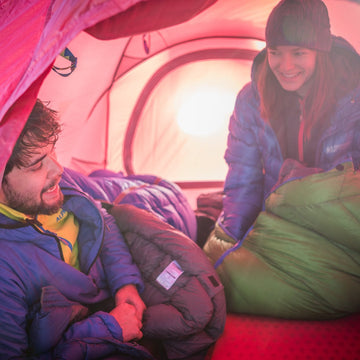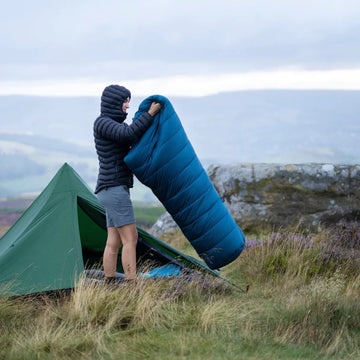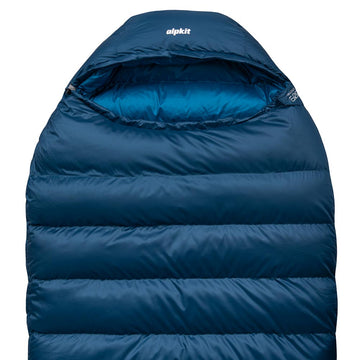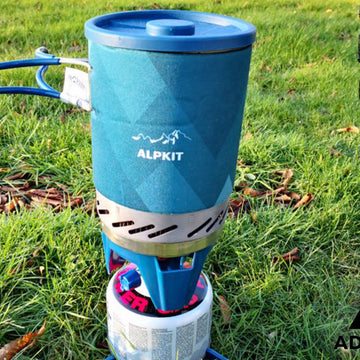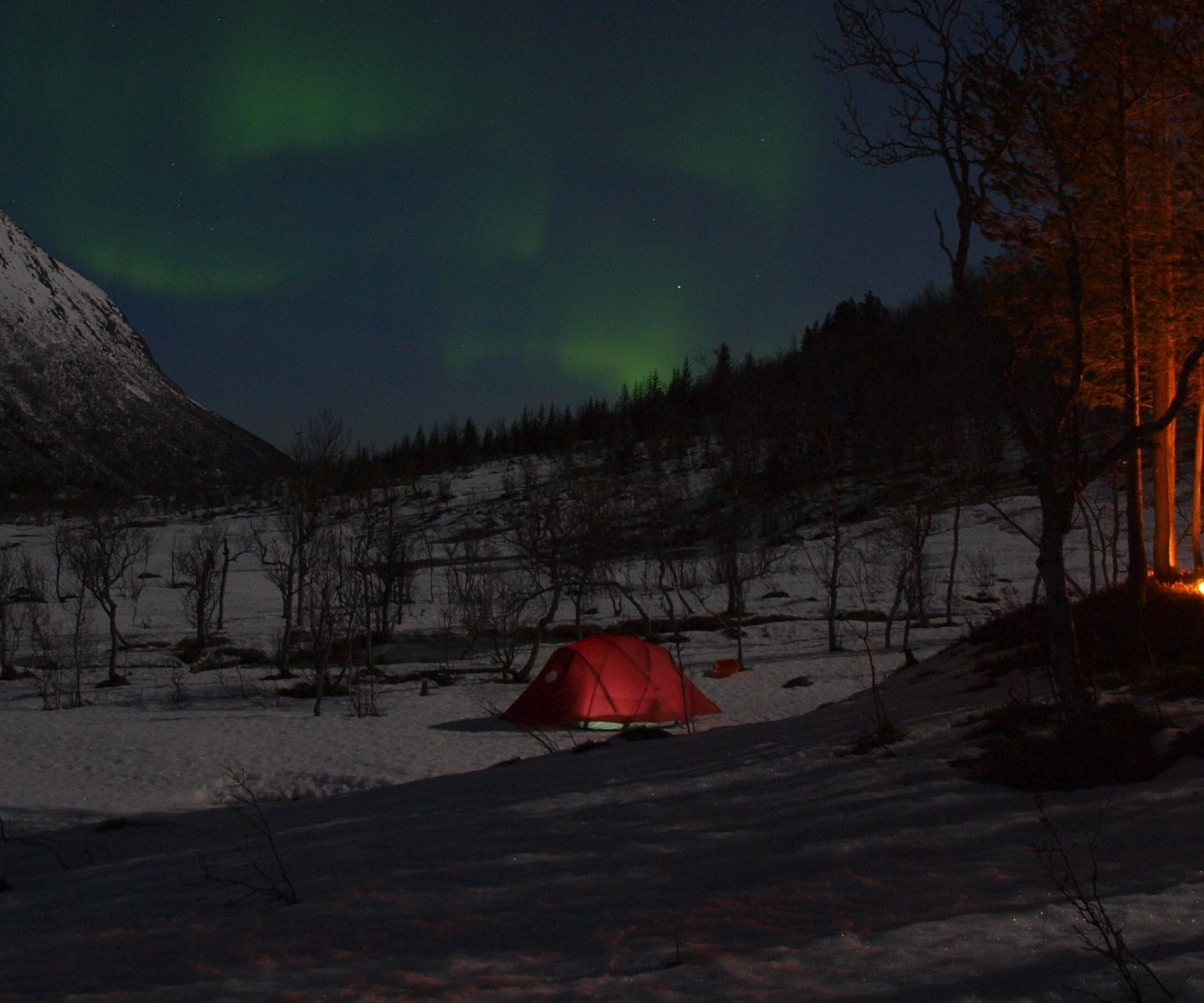
Beat the cold with these 5 essential tips for winter camping. Learn how to layer, insulate and choose the right gear to stay warm all night.
Camping in winter is a magical and rewarding experience, and with the sun approaching the peak of its 11-year solar cycle the opportunity to experience the spectacular Northern lights is high. Go grab your camping kit now and run it past our 5 easy to remember winter camping tips before heading out to find some, hopefully not-so-dark skies.
Camping in winter, how to stay warm
The key to maximising your enjoyment is staying warm through the night. Our 5 factor acronym S.L.E.E.P will act as your trusty guide on this journey. Stay true to it and you'll find that staying cosy and enjoying the beauty of the winter outdoors is not only possible but also quite enjoyable.
Let's explore S.L.E.E.P and discover how it can make your winter camping experience a delightful one.
Surface - what are you going to sleep on?
- Heat loss through the ground can be 3 times greater than heat lost to the air.
- A poor sleeping mat can make an expensive sleeping bag less effective.
- A good sleeping mat:
- Keeps you comfortable from lumps and bumps.
- Acts as a crucial barrier against heat loss.
- In cold conditions, pairing a self-inflating mat with a closed cell mat prevents cold spots.
It's easy to underestimate the heat loss through the ground. Surprisingly, in some tests, researchers discovered that heat loss to the ground can be three times greater than to the air. A subpar sleeping mat can render an expensive sleeping bag almost useless, while a good one can enhance your bag's warmth.
Sleeping mats have an R-Value which indicates how well it insulates you from the cold ground. A sleeping mat suitable for winter will have a R-value of 4 or above. But all is not lost if yours falls below this. A closed cell camping mat is an excellent insulator and can be added very cheaply as an extra layer under your main mat.
The best winter sleeping mat not only shields you from rough terrain but also prevents heat from escaping. When you lie on any insulation your sleeping bag gets compressed, so the sleeping mat acts as your defence against heat seeping into the ground. In colder conditions, this ground heat loss becomes even more significant.
An airbed may be extremely comfortable, but the large uninsulated air chambers will increase the heat loss from beneath.
While airbeds may seem comfy, their uninsulated air chambers escalate heat loss underneath. On the other hand, a closed-cell mat is an excellent insulator that's hard to compress. Combining a self-inflating mat with a closed-cell one can prevent cold spots in freezing conditions, all while maintaining comfort.
Staying warm while camping in winter can help you get the most out of your adventures. If you're looking for more insights, check out our guide on How to choose the best sleeping bag for your next camping adventure. Our ultimate guide covers which sleeping bag insulation is right for you (down or synthetic), what sleeping bag temperature ratings mean, and how to choose the best bag possible.

Layers - What are you going to wear inside your sleeping bag?
- Layering clothing is crucial to reduce heat loss.
- Clothing and sleeping bag liners help regulate body temperature.
- Don't sleep in the same damp clothes you wore during the day.
- Keeping dry gloves, socks, and thermals for sleeping boosts comfort.
- Use a down jacket or fleece as a mini blanket inside your sleeping bag.
- Hood and neck baffles prevent warm air from escaping and cold air from entering.
Layering clothing is second nature to outdoor enthusiasts. It allows you to manage your body temperature across a broader range.
Avoid sleeping in the same clothes you wore during the day, as they might be damp, causing you to cool faster. Damp clothing can increase heat loss by up to 25 times compared to dry garments. Keep a set of dry gloves, socks, and thermals for sleeping to boost your comfort. Wearing thermals also eases those late-night trips out of the tent.
Heat loss from damp clothing can be up to 25 times faster than dry.
Don't forget to utilise any additional insulation items you have on your trip, like a down jacket or fleece, as a mini blanket inside your sleeping bag. Using the hood and neck baffles effectively seals your bag, preventing warm air from escaping and cold air from creeping in. Also consider using a sleeping bag liner.
Knowing more about 5 tips for staying warm while camping in winter allows you to make informed decisions when heading outdoors. Looking for real-world feedback? Check out our review PipeDream 400 is your ultralight sleeping bag for multi-day camping adventures. Discover Pat Kinsella's rave review on the Alpkit Pipedream 400 sleeping bag. Designed for year-round adventurers, it promises unbeatable warmth, ultra-lightweight, and impeccable design.
Eat & Drink - Take on enough fuel to keep you warm all night
- Quick-burning kindling (sugary foods) provides a rapid energy boost.
- Complex carbohydrates (pasta, rice, dried fruit) release energy more slowly.
- Proteins (meats, fish, cheese, nuts) and fats (margarine) act as substantial fuel.
- Stay hydrated; dehydration can lead to a cold night's sleep.
- Alcohol increases heat loss and should be avoided before bedtime.
Proper nutrition and hydration are essential components of a successful camping experience, especially in cold conditions. Adequately fueling your body and maintaining hydration helps in maintaining your internal temperature, ensuring you stay warm and comfortable throughout the night.
Think of food as fuel for a fire. Quick-burning kindling, like sugary snacks and carbonated drinks, provides an initial burst of energy but fizzles quickly. Complex carbohydrates (pasta, rice, dried fruit) serve as slower-burning fuel, much like sturdy logs sustaining a fire. Proteins (meats, fish, cheese, nuts) and fats (margarine) act as substantial logs.
Proper hydration is vital to convert food into energy, especially in cold weather when your thirst mechanism may be dulled. Exhaling in cold air expels a significant amount of water, compounding dehydration. Remember, waking up cold in the middle of the night often results from inadequate fuel or dehydration, so stay nourished and hydrated.
Understanding the best kit to keep you warm is just part of our winter adventure. If you're looking for deeper knowledge, check out our guide on 10 great recipies for camping in winter. Our Winter Chef keeps the chill out with meals hot off the camp stove, stay fueled and savour comfort in every bite, letting your adventures simmer a little longer.
Extremities - You can't sleep if you have cold feet
- Head, hands, and feet are packed with blood vessels and feel the cold first.
- Wearing a hat, warm socks, and gloves keeps extremities warm.
Your head, hands, and feet are packed with blood vessels and feel the cold first. If these extremities are chilly, it can disrupt your sleep and make your entire body feel cold. Wearing a hat inside your sleeping bag can significantly affect your comfort. Putting on warm, dry socks and gloves keeps your hands and feet toasty. Adjust your attire as needed to match the conditions.
If your head, hands, or feet are cold, you will find it hard to get to sleep and it could have the effect of making the rest of your body feel cold.

Protection - Keep your sleeping bag dry
- Choose your shelter wisely (bothy, tent, snowhole, Alpine hut).
- Protect yourself from precipitation and manage condensation.
- Ensure your sleeping bag remains dry.
- Minimize draughts to reduce heat loss.
- Consider adding a bivvy bag or sleeping bag cover.
Your choice of shelter matters. Whether it's a bothy, tent, snowhole, or Alpine hut, it impacts your sleep. Staying dry in the rain isn't just about precipitation; managing condensation is equally important. Can you dry your sleeping bag during the day if it gets damp?
Minimising drafts in your sleeping area is crucial for heat retention, particularly with thinner sleeping bags. Using a bivvy bag or a sleeping bag can be used as a vapour barrier system, reducing moisture intake into the sleeping system.
Having a reliable and warm sleeping bag provides peace of mind, allowing you to focus on the adventure and the beauty of the experience, rather than worrying about staying warm through the night.
You have your sleeping system sorted but don't forget to take care of the roof over your head. For more advice, check out our guide on How to clean a tent. Keep your tent clean and waterproof. Check out our guide for tent maintenance, with tips on cleaning, storage, and repairs to keep your camp stress-free.
